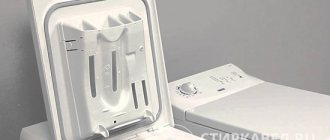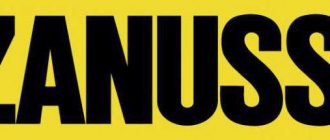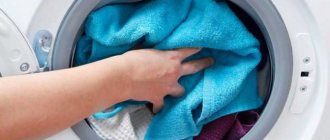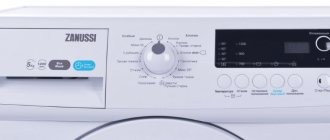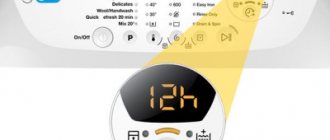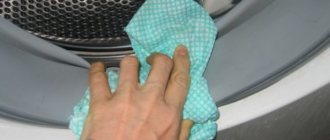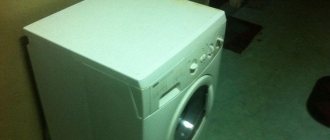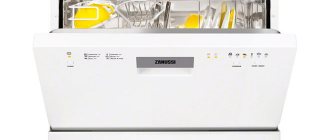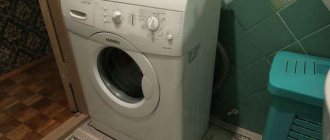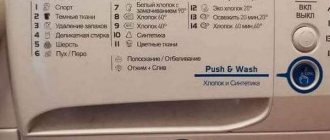Directions and Recommendations
Page 10
- Image
- Text
Directions and Recommendations
Loading laundry
• Divide the laundry into: white laundry, color-
linens, synthetics, fine delicates and wool products.
• Follow the instructions on
labels of items with information on their care.
• Do not wash whites and
colored linen.
• Some colored items may fade
during the first wash. It is recommended to wash them separately for the first time.
• Fasten the pillowcases, close the zippers,
hook the hooks, snap the buttons. Tie the straps.
• Remove all contents from pockets
and straighten things out.
• Turn multi-layer products inside out,
items made of wool and things with appliqués.
• Remove stubborn stains. • Using a special product for
When washing, wash heavily soiled areas.
• Use caution when handling
niya with curtains. Remove hooks or place curtains in a wash bag or pillowcase.
• Do not wash in the appliance:
– linen with raw edges or
cuts;
– bras with underwire; – place small items in a bag
for washing.
• With extremely low load at the start-up stage
there may be an imbalance in the bench press. In this case, manually distribute the items in the drum and start the spin phase again.
Stubborn stains
Water and detergent may not be able to remove some stains.
It is recommended to remove such contaminants before loading clothes into the appliance. There are specialized stain removers available on the market. Use stain removers that are suitable for the specific type of stain and fabric.
Detergents and additives
• Use only detergents
and additives designed specifically for washing machines.
• Do not mix different products for
washing.
• To preserve the environment
Do not use detergents in quantities exceeding those required.
• Follow the instructions on
packaging of these products.
• Choose products that are suitable for
type and color of the specific fabric, wash program temperature and soil level.
• In case of using liquid products
For washing, do not use pre-wash.
• If the device does not have a dispenser
detergent dispenser with flap, add liquid detergent using the dosing ball.
Hardness of water
If the water in your region has high or medium hardness, it is recommended to use water softeners designed for washing machines. In regions where water has low hardness, the use of a water softener is not required. To find out the level of water hardness in your area, contact your local water supply control office. Follow the instructions on the packaging of these products. Units for measuring water hardness: • degrees according to the German standard (°dH);
10
www.zanussi.com
Comments
Select → I found the instructions for my washing machine here! #manualza
- Click →
From the instructions for the VAZ car: - It is not recommended to be in the car at the time of the accident.
Manualza!manualza.ru
Still not with us?
Checking the installation of the washing machine
Before starting the wash, you need to make sure that the automatic washing machine is installed correctly.
Transport parts must be removed from new equipment. They are usually screwed into the back wall of the unit, which helps prevent damage to moving parts during transportation. Turning on the washing machine without removing such bolts may cause it to break.
Before turning on the washing machine, be sure to remove the transport bolts
The unit will not work without connection to communications: water supply, sewerage and electricity. Check whether the tap supplying water to the washing machine is open and whether the hose is connected correctly. The drain hose must be connected to the sewer and straightened along its entire length so that there are no kinks. It is better to select a separate, three-wire socket for the washing machine. The distribution board must be grounded.
The water supply hose must be securely connected to the washing machine.
It is also worth paying attention to the installation location of the equipment - the floor must be level and the surface hard enough to provide shock absorption (concrete, tiles). The washing machine must stand strictly parallel to the floor - you can check the position using a level. Level the equipment by adjusting its legs.
If the unit sways or stands unevenly, its position is adjusted by twisting the legs
It is not difficult to perform such a check, but it will help to avoid significant troubles.
Price list
Below are approximate prices for repairs based on the symptoms of malfunction and the name of the work. The exact amount depends on the complexity of the repair - only a specialist can determine it after diagnosis.
| Symptoms of a problem | Repair time | Price ** |
| Specialist visit and fault diagnosis* | 5-10 minutes | 0 rub.* |
| No drain | from 20 minutes | from 1000 rub. |
| Not warm | 30-60 minutes | from 1800 rub. |
| Indicators are blinking | from 20 minutes | from 1300 rub. |
| Doesn't turn on, power indicator doesn't light up | from 20 minutes | from 1400 rub |
| The drum does not rotate | from 40 minutes | from 1100 rub. |
| No water supply | from 30 minutes | from 1200 rub |
| It makes noise and creaks | from 40 minutes | from 1500 rub. |
| The car is bouncing | from 40 minutes | from 1600 rub. |
| Kicks out traffic jams | 30-60 minutes | from 1800 rub. |
| Leaks | from 30 minutes | from 1200 rub. |
| Doesn't squeeze | from 40 minutes | from 1100 rub. |
| Doesn't open after washing | from 30 minutes | from 1700 rub. |
| The hatch door does not lock | from 30 minutes | from 1700 rub. |
| Rinse mode does not start | from 30 minutes | from 1900 rub. |
| Name of works | Repair time | Price ** |
| Expert visit and diagnostics* | 5-10 minutes | 0 rub.* |
| Replacing the power button | 30 - 50 minutes | from 1400 rub. |
| Repair or replacement of the hatch handle | 30 - 50 minutes | from 1600 rub. |
| Replacing the water pressure sensor | 30 - 60 minutes | from 1700 rub. |
| Water level switch repair | 15 – 40 minutes | from 1100 rub. |
| Replacing the water supply valve | 30 - 50 minutes | from 1600 rub. |
| Replacing the drive belt | 15 – 40 minutes | from 1100 rub. |
| Replacing the drain hose | 30 - 50 minutes | from 1400 rub. |
| Pump replacement | 40 – 70 minutes | from 1900 rub. |
| Heater replacement | 30 - 60 minutes | from 1800 rub. |
| Removing foreign objects from the tank | 30 – 80 minutes | from 1500 rub. |
| Replacing UBL | 30 - 60 minutes | from 1700 rub. |
| Replacing motor brushes | 30 – 80 minutes | from 1400 rub. |
| Replacing the rubber seal | 40 – 80 minutes | from 1900 rub. |
| Bearing replacement | 60 – 180 minutes | from 3000 rub. |
| Replacing the electronic controller | 30 – 70 minutes | from 2200 rub. |
| Electronic controller repair | 40 – 80 minutes | from 2300 rub. |
| Replacing the motor | 40 – 80 minutes | from 2300 rub. |
| Replacing shock absorbers | 40 – 80 minutes | from 1600 rub. |
| Drum replacement | 60 – 180 minutes | from 3700 rub. |
| Replacing the temperature sensor | 30 - 60 minutes | from 1200 rub. |
* If you refuse repairs, you must pay 400 rubles. for calling the master
** Prices are indicated FOR WORK ONLY, the cost of spare parts and consumables is not included in the price
Functional features of different series
The range of washing machines from Zanussi is impressive. You can choose equipment to suit your own needs based on the size of the room, the number of users and the location of the equipment.
In order not to get confused in the diversity, the manufacturer introduced special markings for different series - cars belonging to the same class have a single design feature.
ZWS series – frontal ultra-narrow units
This category is represented by devices with horizontal loading. Washing machines differ from each other in drum capacity, body depth and set of functions.
Drum of washing machines of the ZWS line. A distinctive feature of the series is its compactness along with high capacity. The depth of the equipment is 33-44 cm, the maximum loading range is 4-7 kg
Machines in this series are popular among buyers due to their affordable cost, functionality and ease of installation. The narrow model will fit in a small bathroom or kitchen.
General characteristics of washing units of the ZWS category:
- drum rotation speed is 800-1200 rpm, the quality indicator of the centrifuge is V-C, that is, the output humidity of the laundry is 45-65%, respectively;
- number of programs – 14-15, including “light ironing” and “express wash” modes;
- The Fuzzy Logic intelligent system has been implemented, there are options for enhanced rinsing and delayed start;
- Many models have a removable cover for embedding the washing machine under the countertop.
All ZWS series equipment consumes electricity economically - energy consumption class is A+, A++, A+++. The models are available in white and gray colors, the estimated cost is 210-300 USD.
ZWF series – full-size washing machines
This category of machines differs from the previous series in its increased depth, and therefore the capacity of the drum, which in some models reaches 8 kg.
The rotation speed of the tank in spin mode is 600-1200 rpm, it is possible to select the intensity of the centrifuge. Control of the washing process - mechanical or electronic
Extra options:
- noise level during spinning – 58-79 dB depending on the drum volume and the selected program;
- equipment dimensions – 85x60x60;
- washing class – A, spin class – B-C;
- functions are implemented: express wash, protection of the body from leakage, elimination of imbalance/foaming, delayed start.
Washing corresponding to class A is a good indicator. We talked in more detail about classes and the methodology for defining them in this article.
Many models of the ZWF Series have a child lock on the control panel - a child will not be able to change or interrupt the washing mode. The cost ranges from 300-350 USD.
ZWQ and ZWY series – top-loading machines
Washing machines of these series are produced mainly in Poland. Their main design feature is vertical loading of things.
Compared to their horizontally oriented counterparts, the ZWQ and ZWY series machines have some advantages:
- due to the location of the tank, the washing process can be stopped and items added;
- the width of the unit is within 40 cm - this allows you to effectively use the usable space;
- the drum is attached to two shafts, which means the structure itself is initially more reliable.
However, there are also disadvantages. The top cover must remain free to access. Therefore, the vertical frame cannot be used as a shelf or built under a countertop.
The ZWQ and ZWY series integrate the Fuzzy Logic system and the option of automatic drum positioning - after washing there is no need to manually turn the tub
Top-loading machines have a basic set of programs adapted for various materials. The user panel is located on the top cover of the case. Later representatives of the ZWQ line are supplemented with an informative display.
FCS series - compact low models
Front loading machines, maximum volume – up to 3 kg. The main advantage of the models is their small size. The height of the FCS series washing machines is 67 cm, compared to the standard figure – 85 cm.
This difference gives a wide choice of installation location. Mostly, FCS units are chosen for insertion into kitchen units.
We wrote more about the sizes of washing machines in the following article.
Average characteristics of modifications: spin parameters - 800-1000 rpm, energy consumption - class A, centrifuge efficiency indicator - CD, washing class - B
Mechanical control includes buttons for temperature control, spin speed, program selection and indicators indicating the current stage of operation of the washing machine.
IZ series - washing machines with inclined drum
Units of a non-standard trapezoidal shape - the machine has different depths at the top and bottom of the body. The indicator at the base is 62 cm.
This configuration is due to the installation of an inclined drum on board the washing machine. The tank for loading things is placed at an angle of 5° relative to the horizontal plane - this simplifies the process of loading and unloading laundry.
An inclined model will require more free space for operation than a direct front-loading machine. Capacity of IZ series washing machines – 5 kg
Like most modifications of Zanussi washing machines, products with an inclined drum are equipped with intelligent control and a full list of necessary washing modes. The units are complemented by the super-rinse function and the “Bio-phase” .
ZWI series - built-in modifications
The machines are designed specifically for inserting equipment into furniture sets. ZWI models are in demand among users planning to install a washing machine in the kitchen.
The design feature of the machines is the narrowed bottom and the presence of fasteners for hanging the door. Functionally, the ZWI series units are similar to full-sized frontal washing machines
The capacity of the machines is up to 7 kg, the efficiency indicator is class A++, the spin quality is B. The cost for the ZWI model range is about 500 USD.
Decoding the markings of Zanussi washing machines
All markings can be divided into three blocks. Let's look at the gradation using the example of Zanussi ZWSE7100VS .
In the first block, the letter marking ZWS stands for:
- Z – manufacturer’s name, Zanussi;
- W – type of equipment, Washer – washing machine;
- S – horizontal loading; in vertically oriented models, ZW is followed by the letters Q or Y.
Narrow compact modifications are marked FC - Front Compact, built-in modifications are designated ZWI , where I - Integrated.
Explanation of the name using the example of a front-facing machine ZWSE7100VS. The alphanumeric series characterizes the basic parameters of the washing machine: loading method, capacity, spin speed, series and appearance
The second block displays the functionality of the unit. In our example, it corresponds to the link E710 .
Marker decoding:
- E – letter index indicating the maximum permissible load; the following options are possible: H – 7 kg, G – 6 kg, E – 5 kg, O – 4 kg;
- 7 – release series; the higher the number, the more “saturated” the functionality is - the 7th series cars have child protection and a display, the 6th series does not;
- 10 – centrifuge performance; To determine the actual spin speed, the numerical indicator must be multiplied by 100.
In the third block, the last signs indicate the design of the washing machine - the color of the body and door.
As can be seen from the example, the name of the equipment is systematized - the designation contains the main parameters of the washing machine. Therefore, understanding the labeling will help you navigate the variety of assortments when choosing the appropriate model. We have provided more recommendations for choosing here.
Starting the washing machine
To start the wash, press the “Start” button. The washing machine will lock the door and begin drawing water. In some models of household appliances, in the first minutes you can stop work that has already started - this can be convenient if you need to add laundry to the drum.
To start the wash, you need to press the “Start” button
While the program is running, the corresponding indicators on the dashboard will light up. Also, in many machines, the time remaining until the completion of the cycle is displayed on the display.
To protect the equipment from children interfering with its operation, you can install a special lock, in which the panel will stop responding to button commands. A description of how to turn the protection on and off is described in the operating instructions for the equipment.
Repair prices
You can find a preliminary estimate of the cost of repairing your machine in the tables below. It is divided into two blocks - by name of work and by signs of malfunction. The exact cost of troubleshooting depends on the severity of the breakdown and is determined only by the technician during diagnostics.
| Symptoms of a problem | Repair time | Price ** |
| Expert visit and diagnostics* | 5-10 minutes | 0 rub.* |
| Drain doesn't work | from 20 minutes | from 1000 rub. |
| No water heating | 30-60 minutes | from 1800 rub. |
| Indicators are on | from 20 minutes | from 1300 rub. |
| Doesn't turn on | from 20 minutes | from 1400 rub |
| The drum does not spin | from 40 minutes | from 1100 rub. |
| No water fill | from 30 minutes | from 1200 rub |
| The machine is noisy | from 40 minutes | from 1500 rub. |
| The car is bouncing | from 40 minutes | from 1600 rub. |
| Knocks out the machine gun | 30-60 minutes | from 1800 rub. |
| Leaking | from 30 minutes | from 1200 rub. |
| Spin does not work | from 40 minutes | from 1100 rub. |
| The machine does not open | from 30 minutes | from 1700 rub. |
| The hatch does not lock | from 30 minutes | from 1700 rub. |
| Rinse mode does not start | from 30 minutes | from 1900 rub. |
| Name of works | Repair time | Price ** |
| Specialist visit and fault diagnosis* | 5-10 minutes | 0 rub.* |
| Replacing a button on the control panel | 30 - 50 minutes | from 1400 rub. |
| Repair or replacement of the hatch handle | 30 - 50 minutes | from 1600 rub. |
| Replacing the water level switch | 30 - 60 minutes | from 1700 rub. |
| Water level switch repair | 15 – 40 minutes | from 1100 rub. |
| Replacing the water supply valve | 30 - 50 minutes | from 1600 rub. |
| Replacing the drive belt | 15 – 40 minutes | from 1100 rub. |
| Replacing the drain hose | 30 - 50 minutes | from 1400 rub. |
| Pump replacement | 40 – 70 minutes | from 1900 rub. |
| Replacing the heating element | 30 - 60 minutes | from 1800 rub. |
| Removing a foreign object from the tank | 30 – 80 minutes | from 1500 rub. |
| Replace the hatch lock | 30 - 60 minutes | from 1700 rub. |
| Replacing motor brushes | 30 – 80 minutes | from 1400 rub. |
| Replacing the cuff | 40 – 80 minutes | from 1900 rub. |
| Replacing the drum bearing | 60 – 180 minutes | from 3000 rub. |
| Replacing the control board | 30 – 70 minutes | from 2200 rub. |
| Control module repair | 40 – 80 minutes | from 2300 rub. |
| Replacing the motor | 40 – 80 minutes | from 2300 rub. |
| Replacing shock absorbers | 40 – 80 minutes | from 1600 rub. |
| Tank replacement | 60 – 180 minutes | from 3700 rub. |
| Replacing the temperature sensor | 30 - 60 minutes | from 1200 rub. |
* If you refuse repairs, you must pay 400 rubles. for calling the master
** The price includes ONLY WORK on repair or replacement of parts, spare parts are paid separately
End of wash
When the machine completes the program, a sound signal will sound, a light indication will appear on the display, or the wash end indicator will light up. Now you can open the hatch and unload the laundry.
Manufacturers do not recommend leaving washed clothes in the drum for a long time. It is best to take it out immediately after finishing washing. Then you should wipe the door and rubber cuff with a dry cloth and leave the washing machine hatch open.
After washing, you need to wipe the door and rubber cuff with a dry cloth.
To ensure that your home helper serves you for a long time, follow the operating instructions for the washing machine and our advice!
